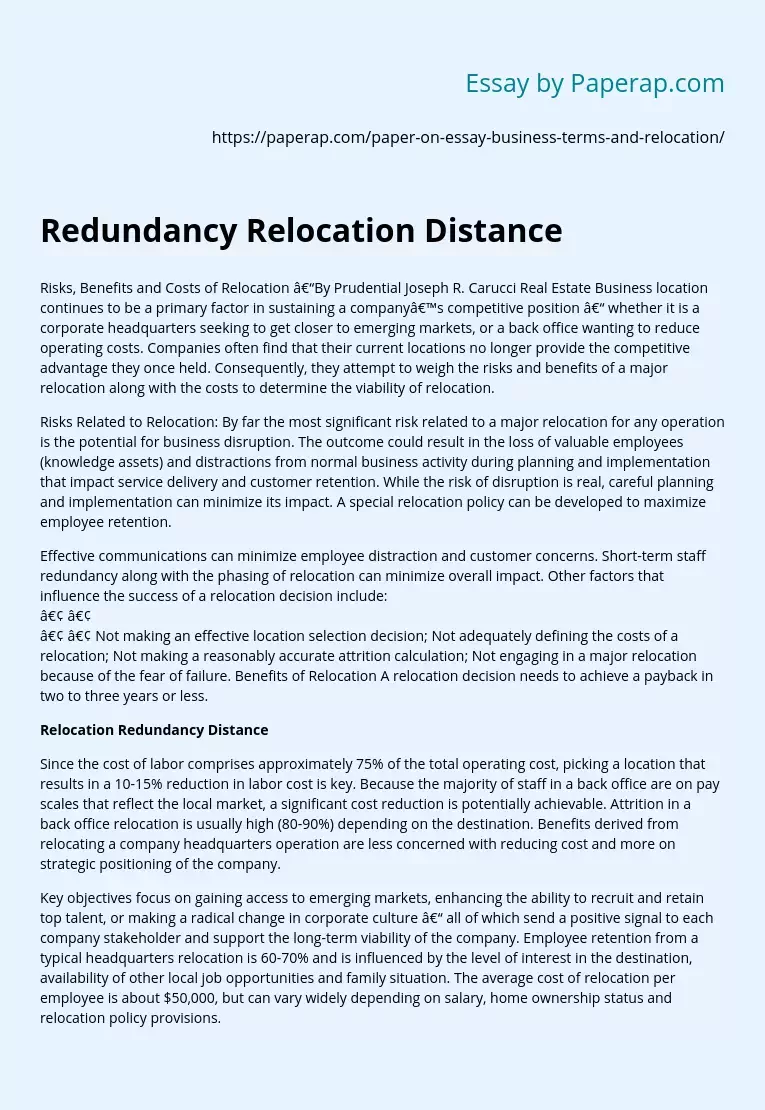Redundancy Relocation Distance
Risks, Benefits and Costs of Relocation –By Prudential Joseph R. Carucci Real Estate Business location continues to be a primary factor in sustaining a company’s competitive position – whether it is a corporate headquarters seeking to get closer to emerging markets, or a back office wanting to reduce operating costs. Companies often find that their current locations no longer provide the competitive advantage they once held. Consequently, they attempt to weigh the risks and benefits of a major relocation along with the costs to determine the viability of relocation.
Risks Related to Relocation: By far the most significant risk related to a major relocation for any operation is the potential for business disruption. The outcome could result in the loss of valuable employees (knowledge assets) and distractions from normal business activity during planning and implementation that impact service delivery and customer retention. While the risk of disruption is real, careful planning and implementation can minimize its impact. A special relocation policy can be developed to maximize employee retention.
Effective communications can minimize employee distraction and customer concerns. Short-term staff redundancy along with the phasing of relocation can minimize overall impact. Other factors that influence the success of a relocation decision include:
• •
• • Not making an effective location selection decision; Not adequately defining the costs of a relocation; Not making a reasonably accurate attrition calculation; Not engaging in a major relocation because of the fear of failure. Benefits of Relocation A relocation decision needs to achieve a payback in two to three years or less.
Relocation Redundancy Distance
Since the cost of labor comprises approximately 75% of the total operating cost, picking a location that results in a 10-15% reduction in labor cost is key. Because the majority of staff in a back office are on pay scales that reflect the local market, a significant cost reduction is potentially achievable. Attrition in a back office relocation is usually high (80-90%) depending on the destination. Benefits derived from relocating a company headquarters operation are less concerned with reducing cost and more on strategic positioning of the company.
Key objectives focus on gaining access to emerging markets, enhancing the ability to recruit and retain top talent, or making a radical change in corporate culture – all of which send a positive signal to each company stakeholder and support the long-term viability of the company. Employee retention from a typical headquarters relocation is 60-70% and is influenced by the level of interest in the destination, availability of other local job opportunities and family situation. The average cost of relocation per employee is about $50,000, but can vary widely depending on salary, home ownership status and relocation policy provisions.
Relocation Cost and Risk/Benefit Analysis Process Risks and benefits will vary for each type of business operation. In a given scenario, a particular condition may be viewed as either a risk or benefit depending on the specific needs of the company. For example, if a company wants to radically change culture and reduce the cost of highly tenured employees, a large percentage of attrition is positive. If there is a significant concern over the potential loss of “intellectual capital” due to a relocation, the company should have its relocation policy reviewed and incorporate provisions that maximize retention.
The analysis process should be comprehensive, and take into consideration short-term risks as well as long-term benefits. Business location consulting firms specialize in preparing relocation analyses and in evaluating relocation alternatives. Factor examined include: retention/attrition of affected employees; one-time costs of relocation and build-out as well as the long-term costs and savings for real estate and labor. The following five-point process will help a company analyze its relocation cost and risk/benefit: 1. 2. 3. 4. 5. Define location and employment level alternatives.
Determine potential employee retention and attrition for alternatives Estimate the one-time costs of relocation, attrition, new staff recruiting/training, etc. Estimate the incremental ongoing cost/savings over a specified period related to the cost of real estate and labor, facility improvements and lease penalties. Identify both the risks and benefits to the company for each location scenario. Whether it’s a short or long-distance relocation, this analysis process will help your company better understand the risks, benefits and costs of relocation.
Redundancy Relocation Distance. (2019, Dec 05). Retrieved from https://paperap.com/paper-on-essay-business-terms-and-relocation/

